1.1-µm Band Extended Wide-Bandwidth Wavelength-Swept Laser Based on Polygonal Scanning Wavelength Filter
Abstract
1. Introduction
2. Experiments
3. Conclusions
Supplementary Materials
Author Contributions
Funding
Institutional Review Board Statement
Informed Consent Statement
Data Availability Statement
Conflicts of Interest
References
- Yun, S.H.; Richardson, D.J.; Kim, B.Y. Interrogation of fiber grating sensor arrays with a wavelength-swept fiber laser. Opt. Lett. 1998, 23, 843–845. [Google Scholar] [CrossRef] [PubMed]
- Yun, S.H.; Boudoux, C.; Tearney, G.J.; Bouma, B.E. High-speed wavelength-swept semiconductor laser with a polygon-scanner-based wavelength filter. Opt. Lett. 2003, 28, 1981–1983. [Google Scholar] [CrossRef] [PubMed]
- Oh, W.Y.; Yun, S.H.; Tearney, G.J.; Bouma, B.E. 115 kHz tuning repetition rate ultrahigh-speed wavelength-swept semiconductor laser. Opt. Lett. 2005, 30, 3159–3161. [Google Scholar] [CrossRef] [PubMed]
- Oh, W.Y.; Yun, S.H.; Tearney, G.J.; Bouma, B.E. Wide tuning range wavelength-swept laser with two semiconductor optical amplifiers. IEEE Photonics Technol. Lett. 2005, 17, 678–680. [Google Scholar] [CrossRef]
- Huber, R.; Wojtkowski, M.; Fujimoto, J.G. Fourier domain mode locking (FDML): A new laser operating regime and applications for optical coherence tomography. Opt. Express 2006, 14, 3225–3237. [Google Scholar] [CrossRef]
- Eigenwillig, C.M.; Wieser, W.; Todor, S.; Biedermann, B.R.; Klein, T.; Jirauschek, C.; Huber, R. Picosecond pulses from wavelength-swept continuous-wave Fourier domain mode-locked lasers. Nat. Commun. 2013, 4, 1848. [Google Scholar] [CrossRef]
- Jirauschek, C.; Huber, R. Wavelength shifting of intra-cavity photons: Adiabatic wavelength tuning in rapidly wavelength-swept lasers. Biomed. Opt. Express 2015, 6, 2448–2465. [Google Scholar] [CrossRef]
- Kassani, S.H.; Villiger, M.; Uribe-Patarroyo, N.; Jun, C.; Khazaeinezhad, R.; Lippok, N.; Bouma, B.E. Extended bandwidth wavelength swept laser source for high resolution optical frequency domain imaging. Opt. Express 2017, 25, 8255–8266. [Google Scholar] [CrossRef]
- Jun, C.; Villiger, M.; Oh, W.-Y.; Bouma, B.E. All-fiber wavelength swept ring laser based on Fabry-Perot filter for optical frequency domain imaging. Opt. Express 2014, 22, 25805–25814. [Google Scholar] [CrossRef]
- Huber, R.; Wojtkowski, M.; Taira, K.; Fujimoto, J.G. Amplified, frequency swept lasers for frequency domain reflectometry and OCT imaging: Design and scaling principles. Opt. Exp. 2005, 13, 3513–3528. [Google Scholar] [CrossRef]
- Eigenwilling, C.M.; Biedermann, B.R.; Palte, G.; Huber, R. K-space linear Fourier domain mode locked laser and applications for optical coherence tomography. Opt. Exp. 2008, 16, 8916–8937. [Google Scholar] [CrossRef]
- Jeon, M.Y.; Zhang, J.; Wang, Q.; Chen, Z. High-speed and wide bandwidth Fourier domain mode-locked wavelength swept laser with multiple SOAs. Opt. Express 2008, 16, 2547–2554. [Google Scholar] [CrossRef]
- Jung, E.J.; Kim, C.-S.; Jeong, M.Y.; Kim, M.K.; Jeon, M.Y.; Jung, W.; Chen, Z. Characterization of FBG sensor interrogation based on a FDML wavelength swept laser. Opt. Express 2008, 16, 16552–16560. [Google Scholar] [CrossRef]
- Isago, R.; Nakamura, K. A high reading rate fiber Bragg grating sensor system using a high-speed swept light source based on fiber vibrations. Meas. Sci. Technol. 2009, 20, 034021. [Google Scholar] [CrossRef]
- Nakazaki, Y.; Yamashita, S. Fast and wide tuning range wavelength-swept fiber laser based on dispersion tuning and its application to dynamic FBG sensing. Opt. Express 2009, 17, 8310–8318. [Google Scholar] [CrossRef]
- Lee, B.C.; Jung, E.-J.; Kim, C.-S.; Jeon, M.Y. Dynamic and static strain fiber Bragg grating sensor interrogation with a 1.3 μm Fourier domain mode-locked wavelength-swept laser. Meas. Sci. Technol. 2010, 21, 094008. [Google Scholar] [CrossRef]
- Kwon, Y.S.; Ko, M.O.; Jung, M.S.; Park, I.G.; Kim, N.; Han, S.P.; Ryu, H.C.; Park, K.H.; Jeon, M.Y. Dynamic sensor interrogation using wavelength-swept laser with a polygon-scanner-based wavelength filter. Sensors 2013, 13, 9669–9678. [Google Scholar] [CrossRef]
- Ko, M.O.; Kim, S.-J.; Kim, J.-H.; Lee, B.W.; Jeon, M.Y. Dynamic measurement for electric field sensor based on wavelength-swept laser. Opt. Express 2014, 22, 16139–16147. [Google Scholar] [CrossRef]
- Ko, M.O.; Kim, S.-J.; Kim, J.-H.; Jeon, M.Y. In situ observation of dynamic pitch jumps of in-planar cholesteric liquid crystal layers based on wavelength-swept laser. Opt. Express 2018, 26, 28751–28762. [Google Scholar] [CrossRef]
- Ahn, S.; Ko, M.O.; Kim, J.-H.; Chen, Z.; Jeon, M.Y. Characterization of second-order reflection bands from a cholesteric liquid crystal cell based on a wavelength-swept laser. Sensors 2020, 20, 4643. [Google Scholar] [CrossRef]
- Lee, H.J.; Kim, S.-J.; Ko, M.O.; Kim, J.-H.; Jeon, M.Y. Tunable, multiwavelength-swept fiber laser based on nematic liquid crystal device for fiber-optic electric-field sensor. Opt. Commun. 2018, 410, 637–642. [Google Scholar] [CrossRef]
- Park, J.; Kwon, Y.S.; Ko, M.O.; Jeon, M.Y. Dynamic fiber Bragg grating strain sensor interrogation with real-time measurement. Opt. Fiber Technol. 2017, 38, 147–153. [Google Scholar] [CrossRef]
- Jeon, M.Y.; Kim, N.; Han, S.-P.; Ko, H.; Ryu, H.-C.; Yee, D.-S.; Park, K.H. Rapidly frequency-swept optical beat source for continuous wave terahertz generation. Opt. Express 2011, 19, 18364–18371. [Google Scholar] [CrossRef] [PubMed]
- Han, G.-H.; Cho, S.-W.; Park, N.S.; Kim, C.-S. Electro-optic swept source based on AOTF for wavenumber-linear interferometric sensing and imaging. Fibers 2016, 4, 14. [Google Scholar] [CrossRef]
- Park, N.S.; Chun, S.K.; Han, G.-H.; Kim, C.-S. Acousto-optic-based wavelength-comb-swept laser for extended displacement measurements. Sensors 2017, 17, 740. [Google Scholar] [CrossRef]
- Chen, M.; Li, H.; Chen, R. Swept laser source based on acousto-optic tunable filter. Proc. SPIE 2014, 9297, 2071321. [Google Scholar] [CrossRef]
- Srinivasan, V.J.; Huber, R.; Gorczynska, I.; Fujimoto, J.G.; Jiang, J.Y.; Reisen, P.; Cable, A.E. High-speed, high-resolution optical coherence tomography retinal imaging with a frequency-swept laser at 850 nm. Opt. Lett. 2007, 32, 361–363. [Google Scholar] [CrossRef]
- Goda, K.; Fard, A.; Malik, O.; Fu, G.; Quach, A.; Jalali, B. High-throughput optical coherence tomography at 800 nm. Opt. Express 2012, 20, 19612–19617. [Google Scholar] [CrossRef]
- Shirazi, M.F.; Jeon, M.; Kim, J. 850 nm centered wavelength-swept laser based on a wavelength selection galvo filter. Chin. Opt. Lett. 2016, 14, 011401. [Google Scholar] [CrossRef]
- Lee, S.-W.; Song, H.-W.; Jung, M.-Y.; Kim, S.-H. Wide tuning range wavelength-swept laser with a single SOA at 1020 nm for ultrahigh resolution Fourier-domain optical coherence tomography. Opt. Express 2011, 19, 21227–21237. [Google Scholar] [CrossRef]
- Shramenko, M.V.; Chamorovskiy, A.; Lyu, H.C.; Lobintsov, A.A.; Karnowski, K.; Yakubovich, S.D.; Wojtkowski, M. Tunable semiconductor laser at 1025–1095 nm range for OCT applications with an extended imaging depth. Proc. SPIE 2015, 9312, 93123B. [Google Scholar] [CrossRef]
- Cao, J.; Wang, P.; Zhang, Y.; Shi, G.; Wu, B.; Zhang, S.; Liu, Y. Methods to improve the performance of the swept source at 1.0 μm based on a polygon scanner. Photonics Res. 2017, 5, 245–250. [Google Scholar] [CrossRef]
- Wang, L.; Wan, M.; Shen, Z.; Wang, X.; Cao, Y.; Feng, X.; Guan, B. Wavelength-swept fiber laser based on bidirectional used linear chirped fiber Bragg grating. Photonics Res. 2017, 5, 219–223. [Google Scholar] [CrossRef]
- Cao, J.; Wang, L.; Lu, Z.; Wang, G.; Wang, X.; Ran, Y.; Feng, X.; Guan, B. High-speed refractive index sensing system based on Fourier domain mode locked laser. Opt. Express 2019, 27, 7988–7996. [Google Scholar] [CrossRef]
- Sung, J.-Y.; Chen, J.-K.; Liaw, S.-K.; Kishikawa, H.; Goto, N. Fiber Bragg grating sensing system with wavelength-swept laser distribution and self-synchronization. Opt. Lett. 2020, 45, 5436–5439. [Google Scholar] [CrossRef]
- Tokurakawa, M.; Daniel, J.M.O.; Chenug, C.S.; Liang, H.; Clarkson, W.A. Wavelength-swept Tm-doped fiber laser operating in the two-micron wavelength band. Opt. Express 2014, 22, 20014–20019. [Google Scholar] [CrossRef]
- Tokurakawa, M.; Daniel, J.M.O.; Chenug, C.S.; Liang, H.; Clarkson, W.A. Ultra-broadband wavelength-swept Tm-doped fiber laser using wavelength-combined gain stages. Opt. Express 2015, 23, 471–476. [Google Scholar] [CrossRef]
- Tan, S.; Yang, L.; Wei, X.; Li, C.; Chen, N.; Tsia, K.K.; Wong, K.K.Y. High-speed wavelength-swept source at 2.0 μm and its application in imaging through a scattering medium. Opt. Lett. 2017, 42, 1540–1543. [Google Scholar] [CrossRef]
- Xu, J.; Zhang, C.; Xu, J.; Wong, K.K.Y.; Tsia, K.K. Megahertz all-optical swept-source optical coherence tomography based on broadband amplified optical time-stretch. Opt. Lett. 2014, 39, 622–625. [Google Scholar] [CrossRef]
- Wei, X.; Lay, A.K.S.; Xu, Y.; Tsia, K.K.; Wong, K.K.Y. 28 MHz swept source at 1.0 μm for ultrafast quantitative phase imaging. Biomed. Opt. Express 2015, 6, 3855–3864. [Google Scholar] [CrossRef]
- Huang, D.; Li, F.; Shang, C.; Cheng, Z.; Wai, P.K.A. Reconfigurable time-stretched swept laser source with up to 100 MHz sweep rate, 100 nm bandwidth, and 100 mm OCT imaging range. Photonics Res. 2020, 8, 1360–1367. [Google Scholar] [CrossRef]
- Huang, D.; Li, F.; He, Z.; Cheng, Z.; Shang, C.; Wai, P.K.A. 400 MHz ultrafast optical coherence tomography. Opt. Lett. 2020, 45, 6675–6678. [Google Scholar] [CrossRef]
- Li, B.; Zhang, C.; Kang, J.; Wei, X.; Tan, S.; Wong, K.K.Y. 109 MHz optical tomography using temporal magnification. Opt. Lett. 2015, 40, 2965–2968. [Google Scholar] [CrossRef]
- Kang, J.; Feng, P.; Wei, X.; Lam, E.Y.; Tsia, K.K.; Wong, K.K.Y. 102-nm, 44.5-MHz inertial-free swept source by mode-locked fiber laser and time stretch technique for optical coherence tomography. Opt. Express 2018, 26, 4370–4381. [Google Scholar] [CrossRef]
- Gerguis, J.O.; Sabry, Y.M.; Omran, H.; Khalil, D. Spectroscopic Gas Sensing Based on a MEMS-SOA Swept Fiber Laser Source. J. Light. Technol. 2019, 37, 5354–5360. [Google Scholar] [CrossRef]
- Tsai, T.H.; Potsaid, B.; Tao, Y.K.; Jayaraman, V.; Jiang, J.; Heim, P.J.S.; Kraus, M.F.; Zhou, C.; Hornegger, J.; Mashimo, H.; et al. Ultrahigh speed endoscopic optical coherence tomography using micromotor imaging catheter and VCSEL technology. Biomed. Opt. Express 2013, 4, 1119. [Google Scholar] [CrossRef]
- Yamashita, S.; Asano, M. Wide and fast wavelength-tunable mode-locked fiber laser based on dispersion tuning. Opt. Express 2006, 14, 9299–9306. [Google Scholar] [CrossRef]
- Takubo, Y.; Yamashita, S. High-speed dispersion-tuned wavelength-swept fiber laser using a reflective SOA and a chirped FBG. Opt. Express 2013, 21, 5130–5139. [Google Scholar] [CrossRef]
- Takubo, Y.; Shirahata, T.; Yamashita, S. Optinization of a dispersion-tuned wavelength-swept fiber laser for optical coherence tomography. Appl. Opt. 2016, 55, 7749–7755. [Google Scholar] [CrossRef]
- Cao, J.; Wang, P.; Zhang, Y.; Shi, G.; Liu, Y. Experimental and theoretical investigation of polygon-based swept source with continuous adjustable free spectral range. Opt. Commun. 2021, 478, 126401. [Google Scholar] [CrossRef]
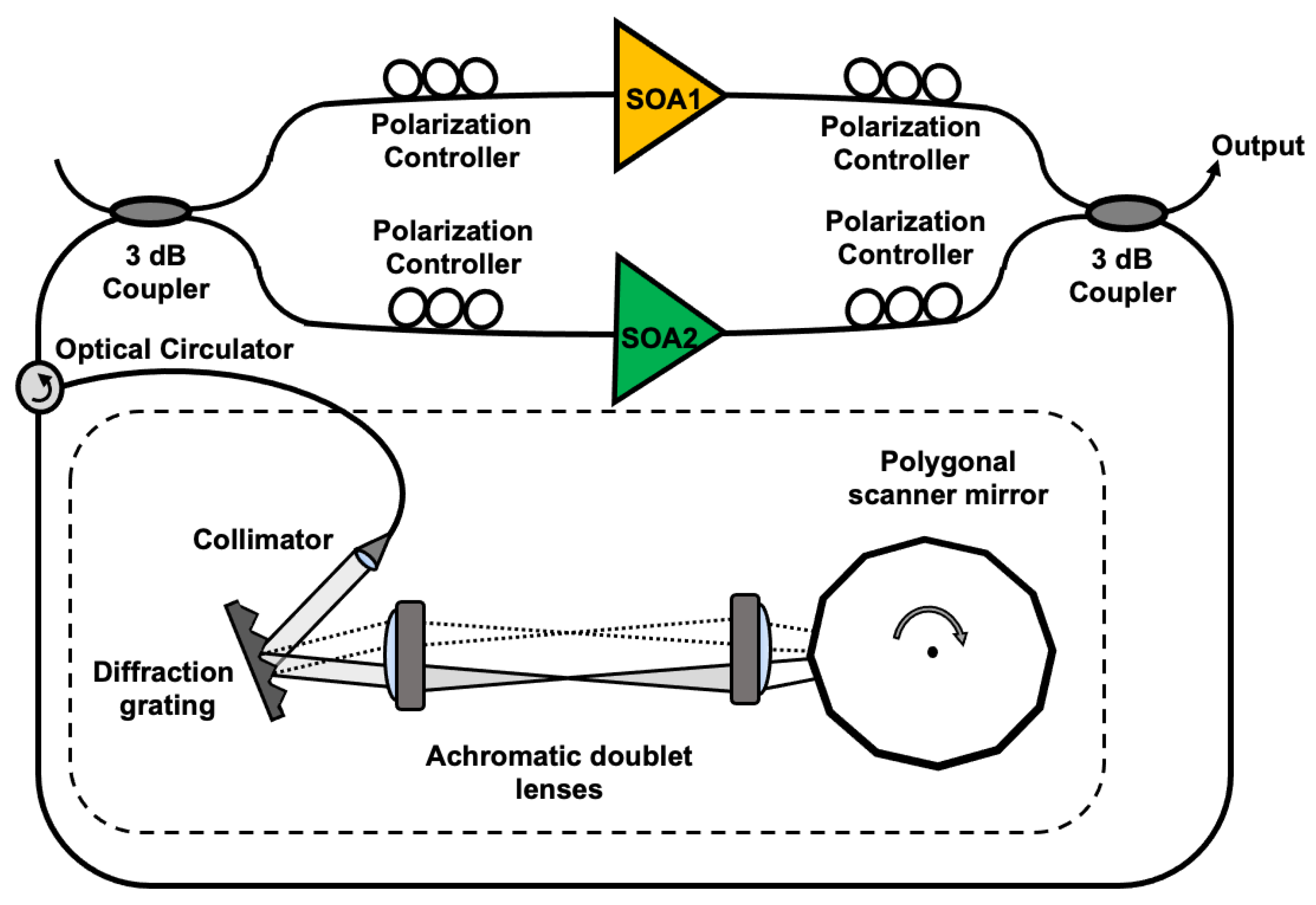
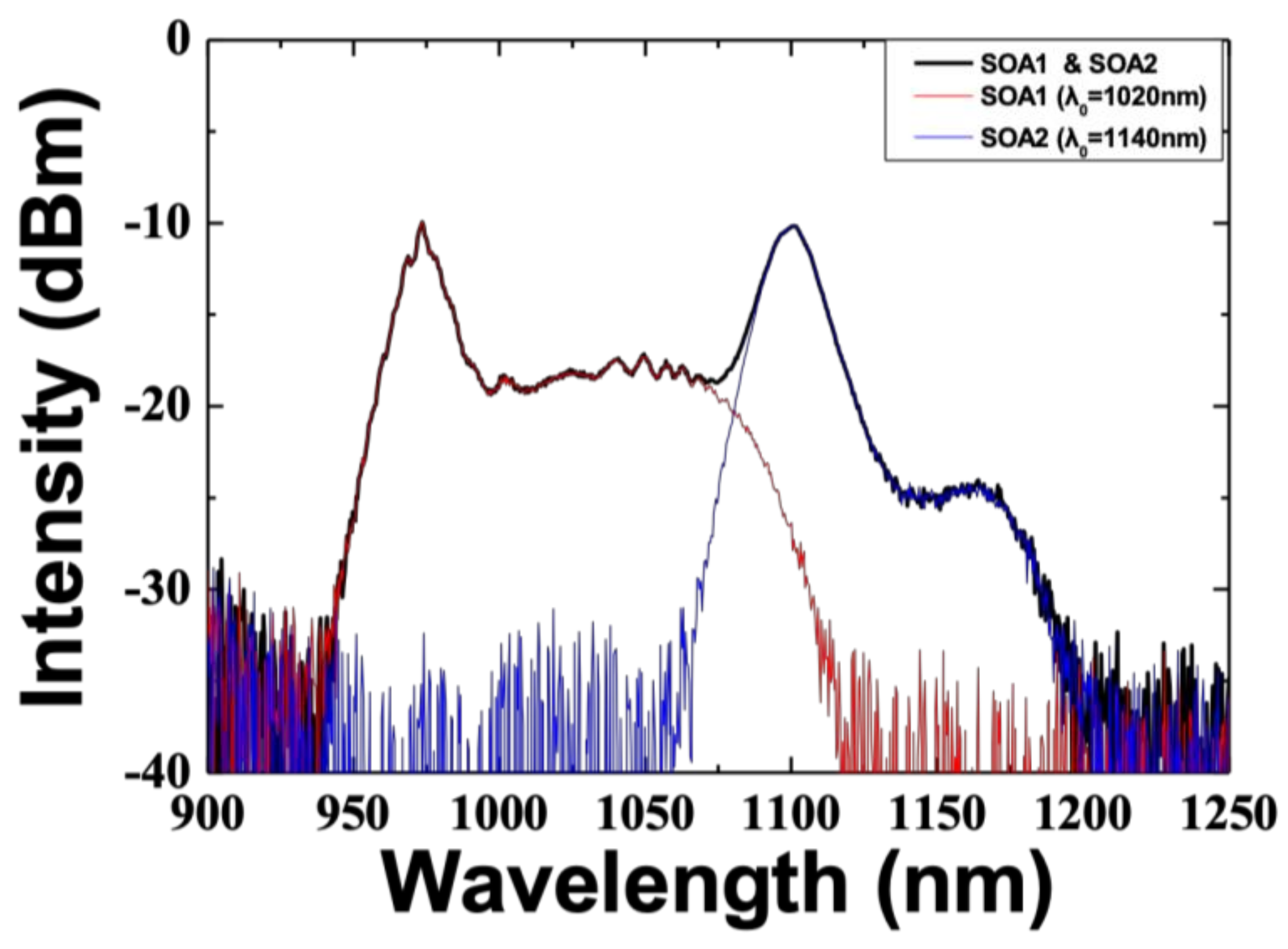
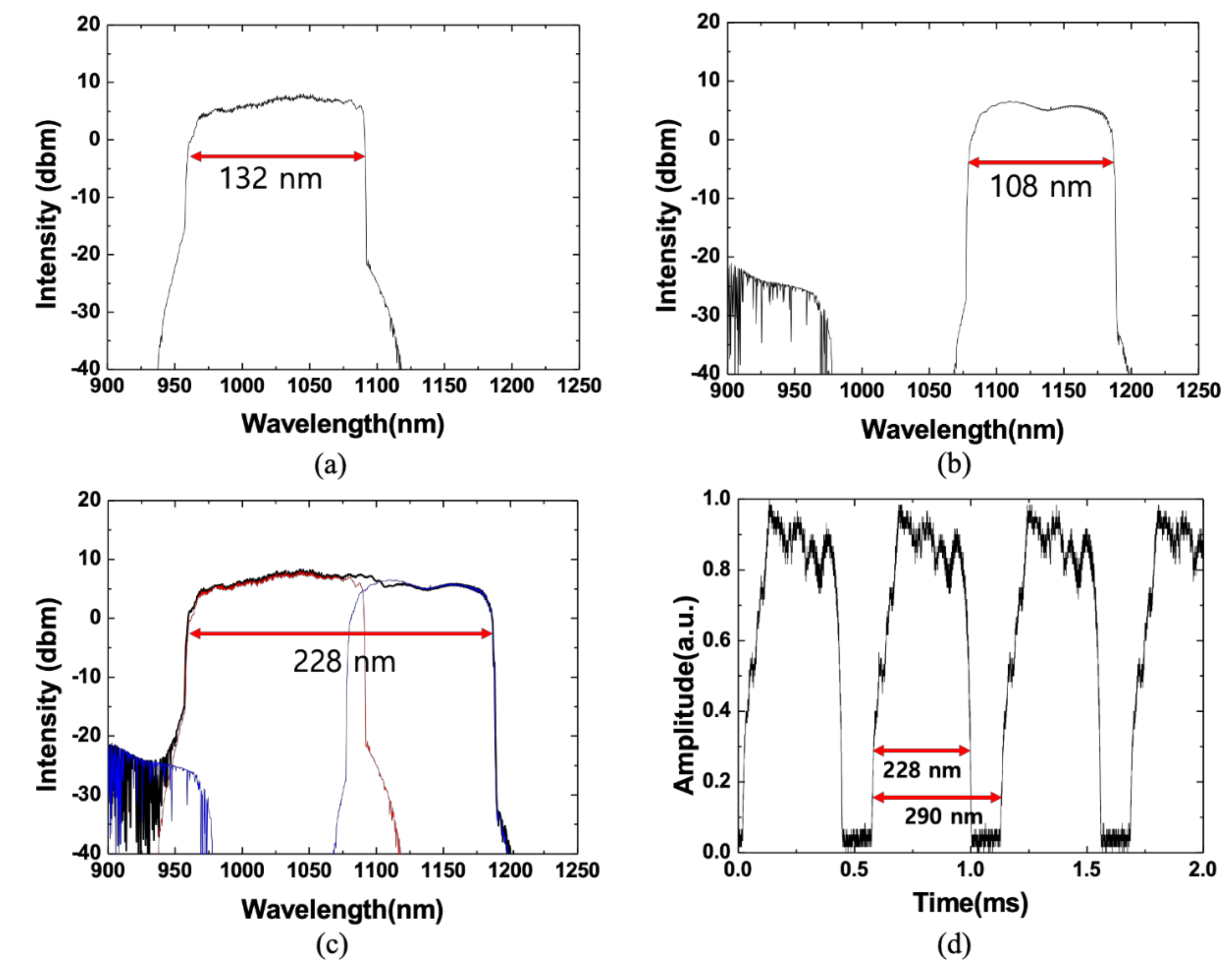
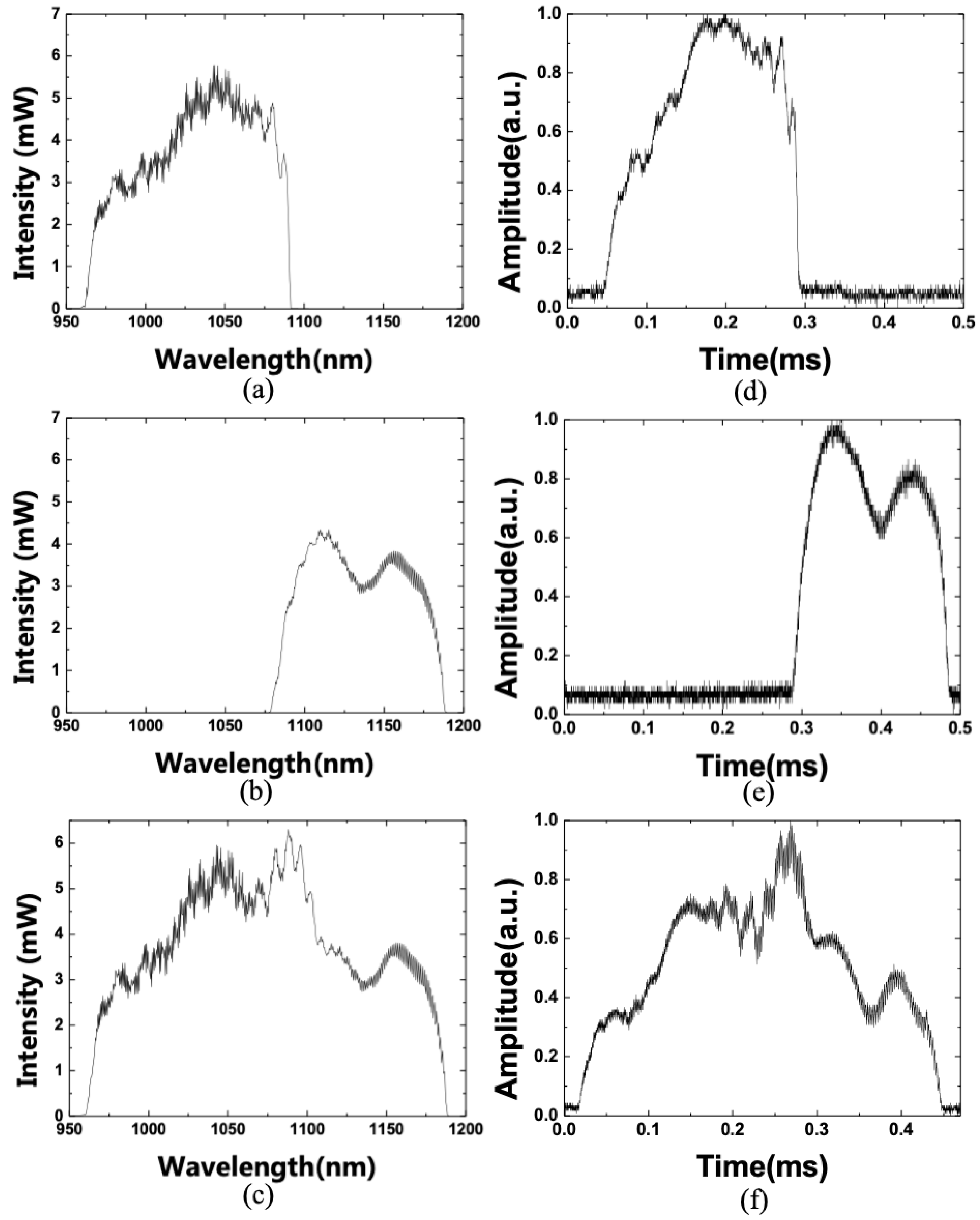
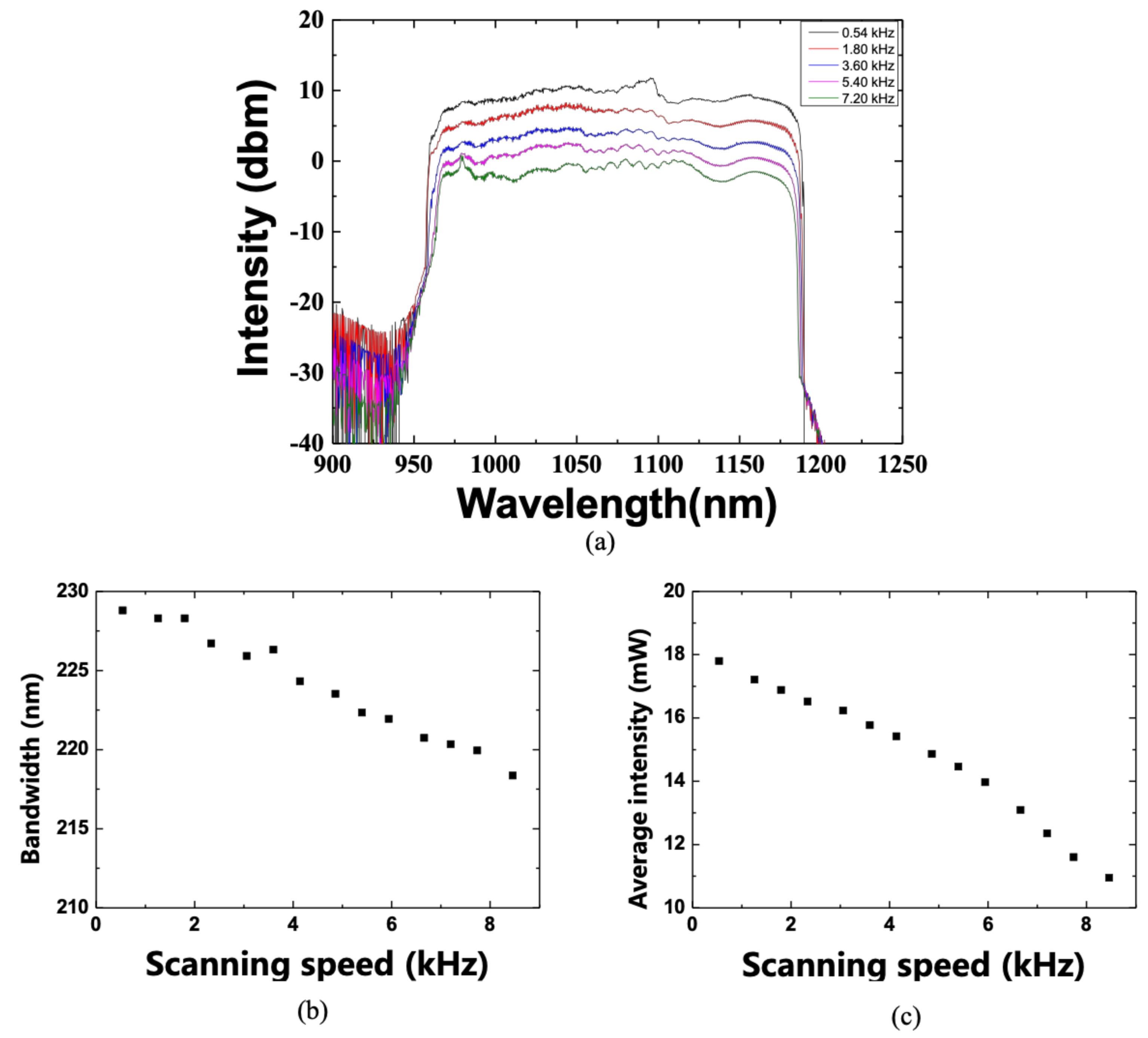
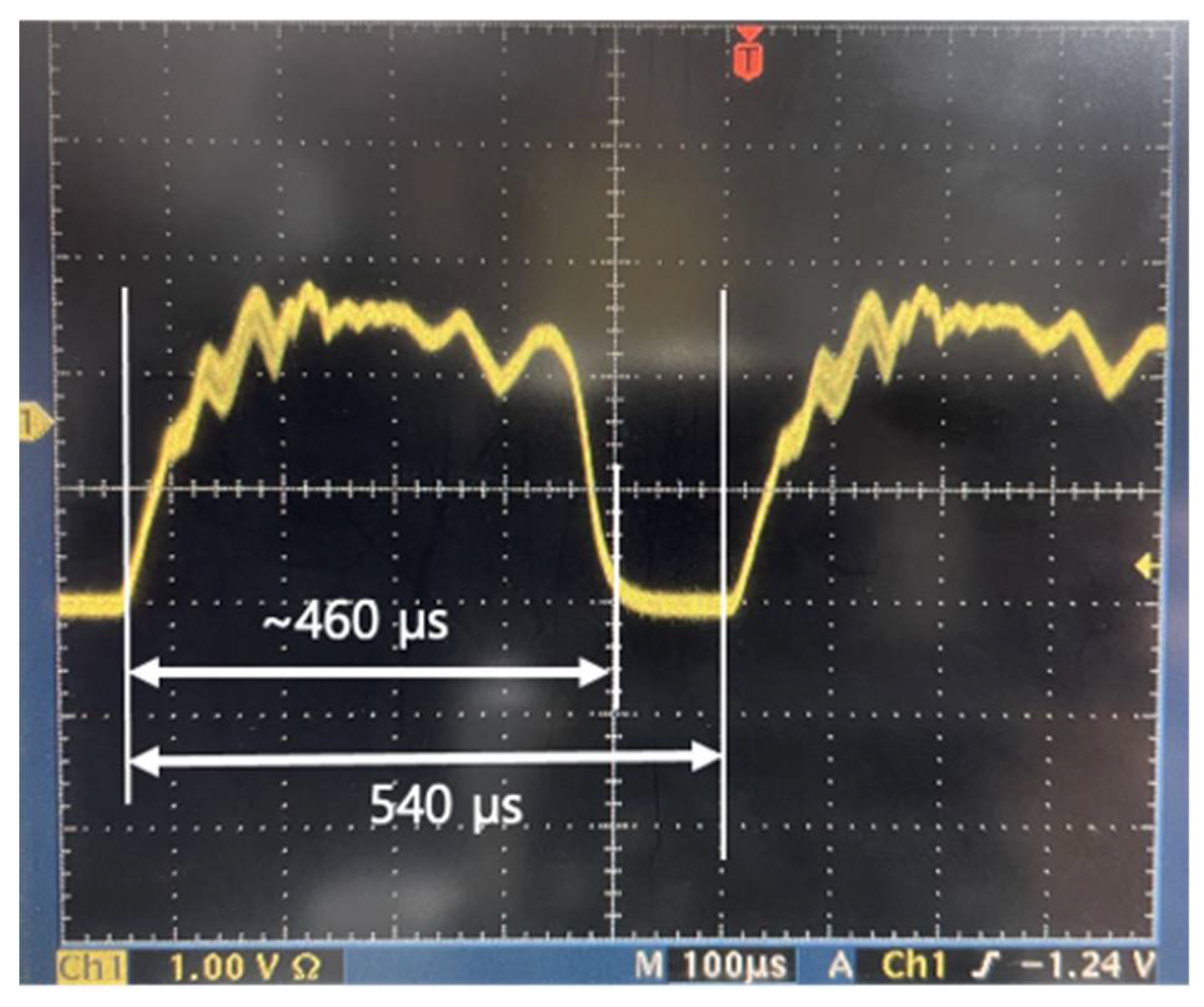
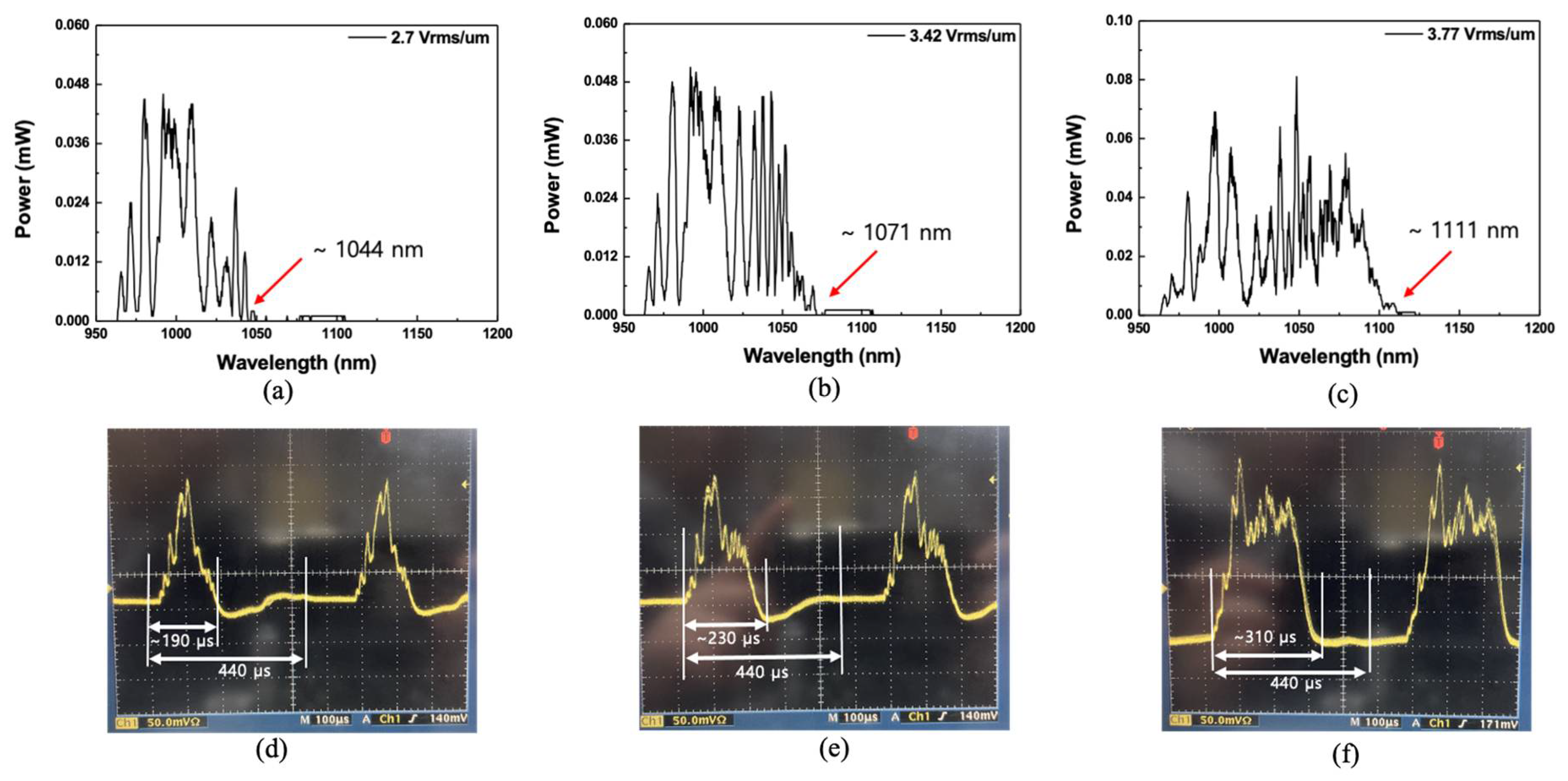
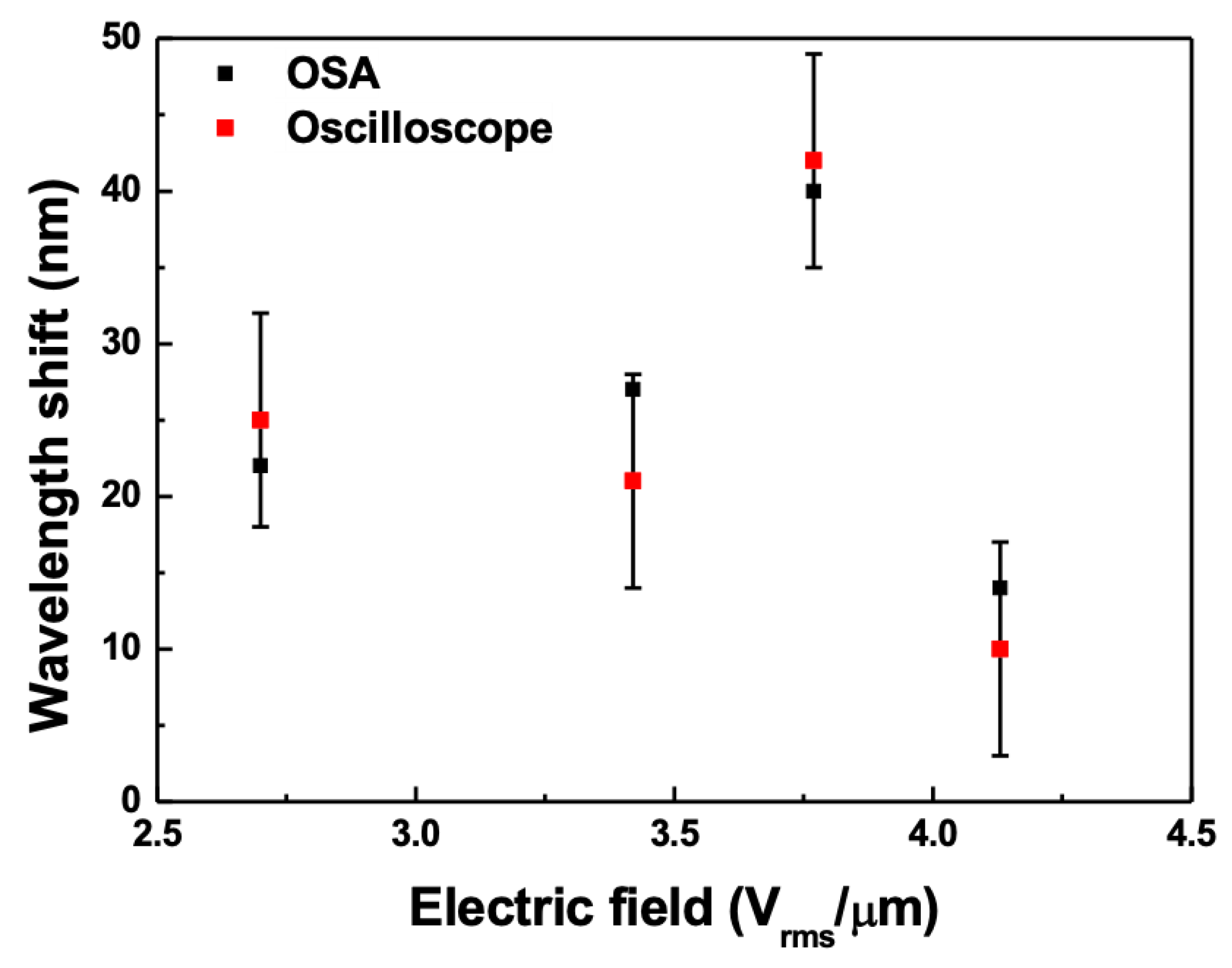
Publisher’s Note: MDPI stays neutral with regard to jurisdictional claims in published maps and institutional affiliations. |
© 2021 by the authors. Licensee MDPI, Basel, Switzerland. This article is an open access article distributed under the terms and conditions of the Creative Commons Attribution (CC BY) license (https://creativecommons.org/licenses/by/4.0/).
Share and Cite
Lee, G.H.; Ahn, S.; Gene, J.; Jeon, M.Y. 1.1-µm Band Extended Wide-Bandwidth Wavelength-Swept Laser Based on Polygonal Scanning Wavelength Filter. Sensors 2021, 21, 3053. https://doi.org/10.3390/s21093053
Lee GH, Ahn S, Gene J, Jeon MY. 1.1-µm Band Extended Wide-Bandwidth Wavelength-Swept Laser Based on Polygonal Scanning Wavelength Filter. Sensors. 2021; 21(9):3053. https://doi.org/10.3390/s21093053
Chicago/Turabian StyleLee, Gi Hyen, Soyeon Ahn, Jinhwa Gene, and Min Yong Jeon. 2021. "1.1-µm Band Extended Wide-Bandwidth Wavelength-Swept Laser Based on Polygonal Scanning Wavelength Filter" Sensors 21, no. 9: 3053. https://doi.org/10.3390/s21093053
APA StyleLee, G. H., Ahn, S., Gene, J., & Jeon, M. Y. (2021). 1.1-µm Band Extended Wide-Bandwidth Wavelength-Swept Laser Based on Polygonal Scanning Wavelength Filter. Sensors, 21(9), 3053. https://doi.org/10.3390/s21093053







